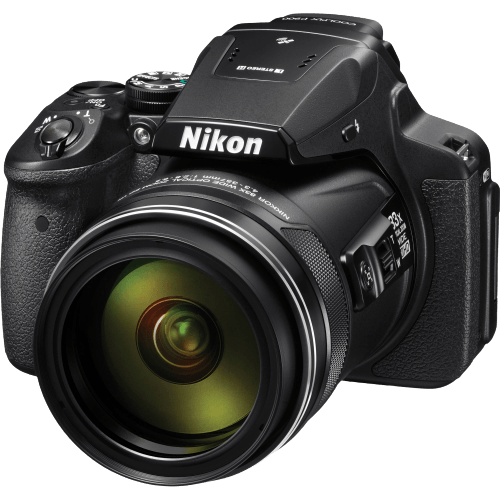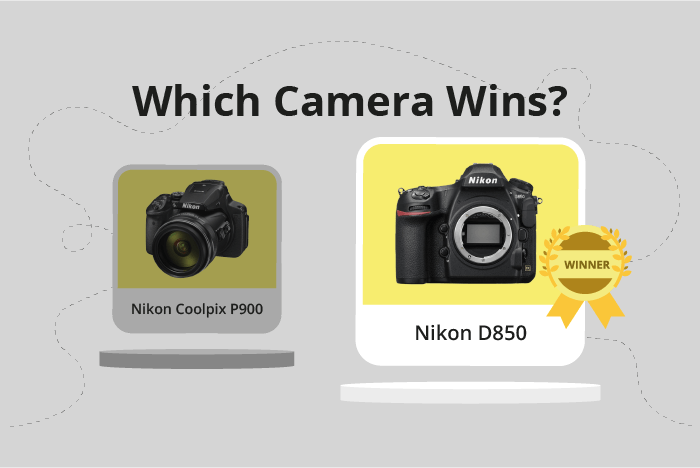Nikon Coolpix P900 vs D850 Comparison
Nikon Coolpix P900

Nikon D850

The Nikon D850 outperforms the Nikon Coolpix P900 with a score of 82/100 compared to 48/100. Both cameras share some common specifications, such as being released by Nikon and having similar dimensions. However, the D850 is a DSLR camera, while the P900 is a bridge camera.
The D850 excels with its higher score, thanks to its superior image quality and versatile features. On the other hand, the P900 has a lower launch price of $599 compared to the D850’s $3300, making it a more affordable option.
In terms of weight, the P900 is lighter at 899g, whereas the D850 weighs 1005g. This could make the P900 a more convenient choice for some users. Despite the differences, both cameras offer unique advantages depending on one’s needs and budget.
Nikon Coolpix P900 vs D850 Overview and Optics
The Nikon D850 outperforms the Nikon Coolpix P900 in optics with a score of 79/100 compared to the P900’s 53/100. Both cameras share common specifications, such as a CMOS sensor, a shooting speed of 7 frames per second, and a similar processor family (Expeed C2 for the P900 and Expeed 5 for the D850). However, there are significant differences that lead to the D850’s higher score.
The D850 has a remarkable 45.7-megapixel resolution, while the P900 only has 16 megapixels. This difference allows the D850 to capture more detail and produce higher quality images. Additionally, the D850 has a full-frame sensor, which contributes to better low-light performance and a shallower depth of field. The P900 has a smaller 1/2.3″ sensor, which can limit its capabilities in certain situations. Furthermore, the D850 has a DXOMARK score of 100 for its sensor, which is significantly higher than the P900’s score of 72.
On the other hand, the P900 has built-in image stabilisation, which can help reduce camera shake and blur in photos. The D850 lacks this feature, which may require users to rely on stabilised lenses or external stabilisers. However, the D850 has a lens mount, allowing users to choose from a wide variety of lenses to suit their needs, while the P900 does not have this option.
Considering these factors, the Nikon D850 is superior in terms of optics due to its higher resolution, full-frame sensor, and lens mount compatibility. The P900 does have the advantage of image stabilisation, but its lower resolution and smaller sensor limit its overall performance. Therefore, the D850 is the clear winner in this comparison.
Nikon Coolpix P900 vs D850 Video Performance
The Nikon D850 outperforms the Nikon Coolpix P900 in video capabilities, with a video score of 70/100 compared to the P900’s 61/100. Both cameras share some common features, such as built-in time-lapse functionality, allowing users to create stunning time-lapse videos with ease.
The D850’s superiority in video capabilities is evident in its maximum video resolution and dimensions. The D850 offers 4K video resolution (3840 x 2160), providing crisp, detailed footage that is ideal for professional use or high-quality content creation. In contrast, the P900 only offers standard HD video resolution (1920 x 1080), which may not meet the needs of users seeking top-notch video quality.
However, the P900 does have an advantage in its maximum video frame rate, offering 60fps compared to the D850’s 30fps. This allows the P900 to capture smoother footage, especially in fast-paced situations. This feature may appeal to users who prioritize smooth motion over resolution in their videos.
Taking these factors into account, the Nikon D850 is the better choice for users who require exceptional video quality and resolution, making it suitable for professional projects and high-quality content. On the other hand, the Nikon Coolpix P900 may be a more suitable option for those who prioritize smooth motion and a higher frame rate, despite its lower overall video score and resolution. Ultimately, the choice between these two cameras for video capabilities depends on the user’s specific needs and preferences.
Nikon Coolpix P900 vs D850 Features and Benefits
The Nikon D850 emerges as the winner with a feature score of 87/100, compared to the Nikon Coolpix P900’s score of 41/100. Both cameras share some specifications, such as a WIFI feature and a 3-inch (or larger) screen. However, the D850 surpasses the P900 in several aspects, while the P900 excels in a few areas of its own.
The D850’s 3.2-inch screen is larger than the P900’s 3-inch screen and boasts a higher resolution of 2,359,000 dots, compared to the P900’s 921,000 dots. Additionally, the D850 features a touchscreen, allowing for easier navigation and control. The D850 also comes with Bluetooth, which the P900 lacks, enabling seamless connectivity and file transfers.
On the other hand, the Coolpix P900 has a flip screen, which offers more flexibility in shooting angles and is particularly useful for capturing images and videos in challenging situations. The P900 also has a built-in GPS, allowing users to geotag their photos and track their locations during shoots, a feature absent in the D850.
Despite the P900’s advantages, the D850’s superior screen resolution, touchscreen capabilities, and Bluetooth connectivity make it a more feature-rich camera. The P900’s flip screen and GPS functionality are notable benefits, but they do not outweigh the D850’s advantages. As such, the Nikon D850 is the better option for those seeking a camera with more advanced features.
Nikon Coolpix P900 vs D850 Storage and Battery
The Nikon D850 outperforms the Nikon Coolpix P900 in storage and battery with a score of 84/100, compared to the P900’s 21/100. Both cameras share similarities, including accepting SD, SDHC, and SDXC memory cards and lacking USB charging capabilities.
The D850 surpasses the P900 by offering two memory card slots, allowing for more storage capacity and flexibility. Additionally, it is compatible with UHS-II and XQD cards, providing faster data transfer rates. The D850 also boasts a significantly longer battery life, with 1840 shots per charge compared to the P900’s 360 shots, using the more powerful EN-EL15a battery.
The P900’s advantage lies in its simplicity, offering a single memory card slot and a less complicated storage system. However, this does not outweigh the D850’s superior storage and battery capabilities.
Given these factors, the Nikon D850 is the clear winner in terms of storage and battery performance, providing users with more storage options and longer shooting times. The Nikon Coolpix P900 may suffice for casual photographers, but the D850 is undeniably better for those who require more storage flexibility and extended battery life.
Nikon Coolpix P900 vs D850 – Our Verdict
Are you still undecided about which camera is right for you? Have a look at these popular comparisons that feature the Nikon Coolpix P900 or the Nikon D850:

